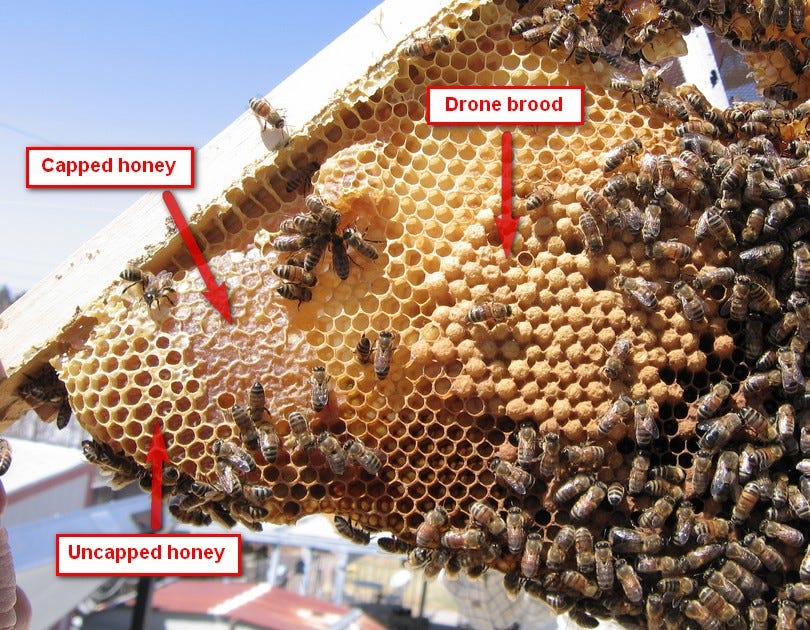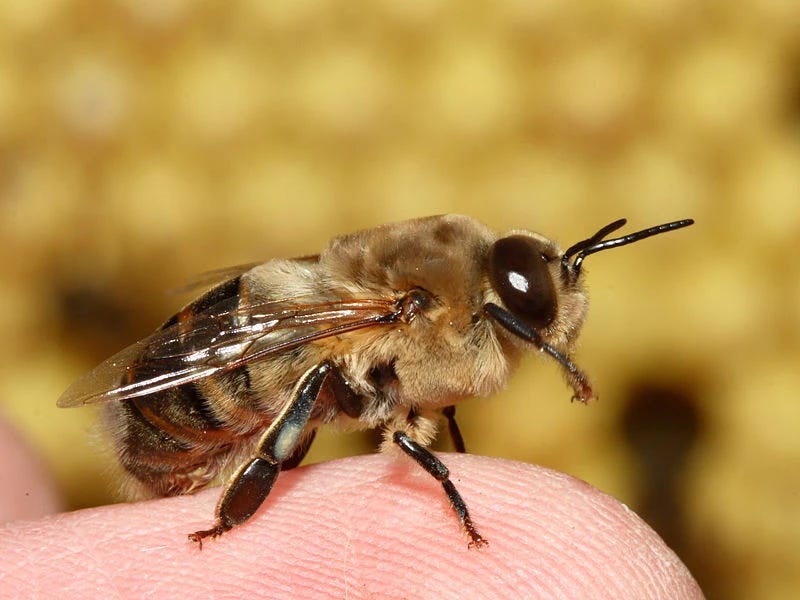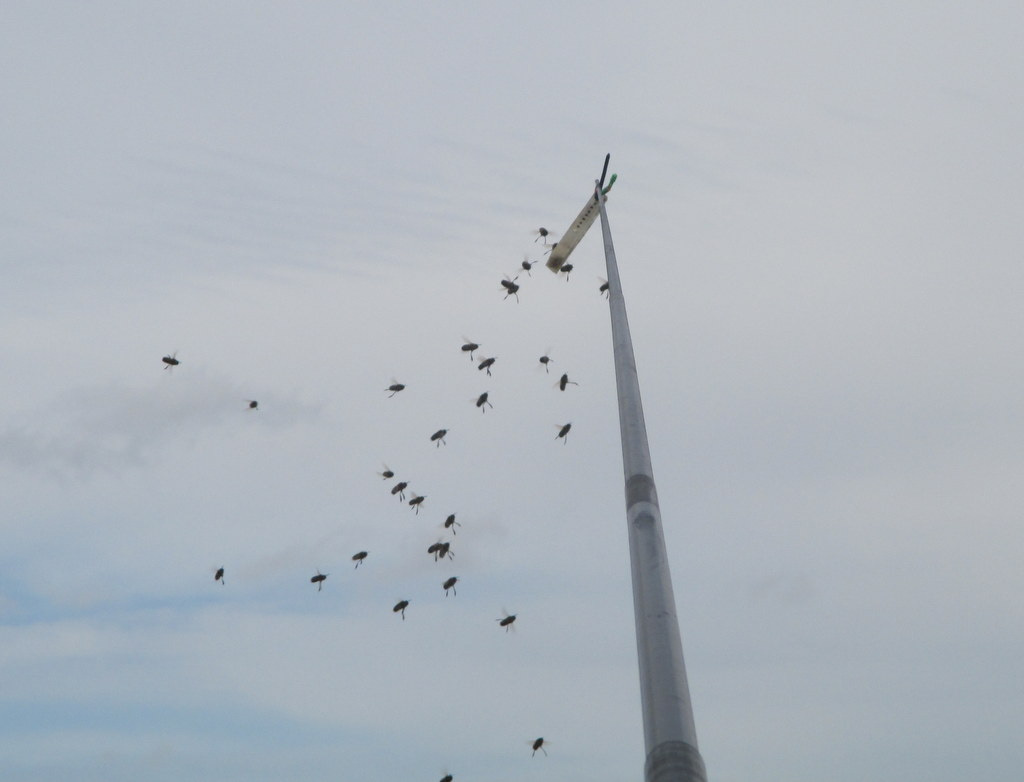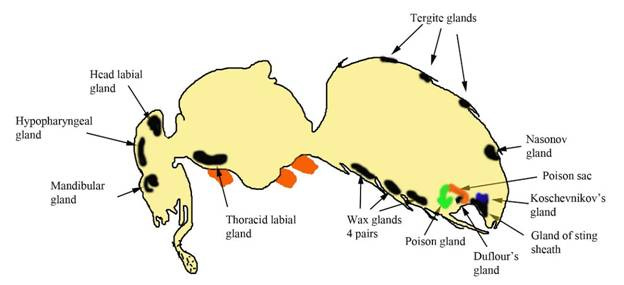Drone Bees: More Than Just Deadbeat Dads
Droning on about the under-appreciated resident of the hive
Today we’re talking about the not-literal parasite of the bee world, drones. Male bees. They live, they fuck, they die. That’s been their story since we’ve studied bees. But is it accurate?
So, we should all know at this point (if you’ve been reading along to this point) what a drone is. The traditional understanding has been that drones exist, like I said, to promote genetic diversity by mating with queens from other hives. They eat, don’t harvest pollen, and just basically hang out. Anyways, is this all true? Well, sort of. As a beekeeper, however, drones can act often as a canary in a coal mine. They can indicate problems— are there tons of drones flying around in the fall? Are there a lot of dead drones lying around outside? These can be crucial indicators of what’s going on inside your hive.
If they’re outside in August or September, the hive is kicking them out to save their food stores. They’re preparing for famine. Not a good sign— and paying attention to your drones in this way means you don’t need to crack open your hive and see what’s going on, and the fewer times you have to go in, the better off for the hive's health.
So they still serve some purpose in the hive, hence why it’s a bad thing to be seeing them all kicked out in the early fall. There are no free rides in nature, which shouldn’t be a surprise, so it’s surprising that the science is just starting to catch up to what drones offer in a hive. They’re the bigger, fluffier bees. In the winter, when the hive is trying to keep its temperature warm to keep everyone alive, those big, fluffy drones, who typically exist on the outer spaces of your hive, will also provide basically a warm blanket over the hive. The drones are laid out on the edges of the comb for this reason, and this will be important for varroa management, as we’ll discuss. So, the bees are making a risky decision to cut the drones loose early, and the severity of the winter will decide whether or not that decision proves fatal. They aren’t just useful for understanding hive health from this perspective, but also their main focus, genetic diversity. And this I don’t think really gets talked about enough outside of people who rear queens.

For folks who don’t know, your worker bees, those ladies you got with your bee package, are not biologically related to the queen. The worker bees born to the queen are, but since they cannot reproduce, that doesn’t really do anything for diversity. It’s only the drones born to the queen that carry her genetic code. And, just like any other species, if you have weak queens, then the genetics passed down are less likely to be good for the future of the species. If you’ve got a good queen, well then work like hell to make sure those drones survive and are successful in mating with other queens, right? The queen you get with a package is already mated. Ideally, though, we’d like to see a future where we aren’t relying on bees from far-off states for new colonies, but ones that have locally adapted to the climactic conditions and floral species of a region.
I don’t think anyone is under the impression that honeybees will be naturalized in many parts of the country, even if they do become naturalized in some places. Despite swarms every year, those hives don’t often last very long out in the wild. And maybe there’s a case to be made that keeping them this weak helps protect ecosystems from having them compete outside of human-intervened areas with native pollinators, that’s probably a conversation for another day.
Now what’s interesting about drones is that they do not carry biological information from their father— just their grandfather. They come from unfertilized eggs and are genetically identical to the queen who laid them. What this also means is that if we’re breeding queens in specific, centralized ways, there just isn’t a lot of genetic diversity getting passed around. And this is an issue breeders are starting to run into.
A queen may mate with up to 20 drones, but those drones are all likely from the same handful of genetics, at the breeder’s apiary. And this is not just a problem for the diversity of genetics, but we even have evidence that drones are weaker— flying shorter distances to mate, flying more slowly, and struggling to actually mate in comparison to the past— we’re going to talk about this in more detail shortly.1
For a bug that has to live out in nature, those aren’t good traits. Now let’s put this genetics issue into context. Most of our bees that are sold as packages come from a handful of producers. There are around 8 major producers of bee packages from Georgia, which supplies a large part of the bees used by most beekeepers east of the Mississippi. That’s over 60,000 packages, plus 20,000 additional queens every year.
Not only are the drones special because of the role they play in keeping the hive warm and genetic information, but we see some unique things happen when drones are around. For example, they’re raised in special cells, because they’re bigger, and those cells are usually on the outer part of the hive. So they grow up, get ready to mate, and head out of the hive and join a drone congregation.
A drone congregation area (DCA) is a specific place where male honey bees gather and wait for young queens to visit. They are different from most mating areas because they are high above ground, and suspended in air. All honey bee mating takes place in these areas—never on the ground or in the hive. And the term we use that helps explain where these drones came from to congregate is called drift. We can have some control over the drift of our drones by paying attention to the landscape features that impact which way drones will fly and ultimately congregate. So while you don’t have much control over the beekeepers around you who may have weak genetics, you can control where you put your hive in relation to the other hives in your area and reduce some of that cross-pollination. The science on this is pretty much not understood, but we know it has a relationship with the horizon and is typically a key feature on the landscape, like the edge of a tree in a field, or an opening in a forest. We basically don’t really know but know it seems to be on these marginal spaces.
Now, to transition back to the drones themselves, we can take advantage of understanding how drones exist in a hive to track and even eliminate Varroa mites without the use of literally anything. Kim Flottum, a prominent bee author and researcher, has a system he uses for keeping his bees from ever having mite issues. It’s fairly simple if you understand how beehives work. So we mentioned before how drones exist on the edge of the hive, especially when they’re in the comb, right? Well, what he’s discovered is that if you put in new frames with no comb on the edges of your mediums. He uses the second and 6th frames, which in an 8-frame medium are 2 in from each side. Every week you put a new one in, so the first week, the bottom medium will have the 2nd frame replaced. The next week the bottom medium will have the 7th. The third week the middle medium 2nd frame was replaced, and so on. After about 3 weeks, you’d pull the first frame you put in to see what they’d built out for comb and inspect the drone larvae for signs of mites.
So you’re functionally setting up mite traps, the drones are just the bait. And this process, according to Kim, has kept him from having any mite problems for years. That’s it. The mite-infested comb goes to his chickens. The key, though, is you can’t miss a week. Once the mites infest more than just that first entry point, this doesn’t work anymore.2
It’s about working with the system, not trying to stuff it into a box— both literally and figuratively. The added minor benefit of this process is that the comb you’re pulling out with the larvae reduces the amount of drones that the hive is carrying, to an extent. A small extent, because they likely wouldn’t be laying as many drones without human intervention, so it’s not totally devastating to the drones either. There are fewer drones for sure, and if you don’t take breaks from this cycle, it can lead to a limited amount of drones or even no drones at all, but the goal would be once there are no mites showing up to give the rotation a small break of a few weeks, enough for some drones to start hatching, and then to continue again. This process might take 6-8 weeks before you’re back to zero mites if your first one had mites in it.
We covered the fact that drones, because they carry the same exact genetics as their mother, are particularly valuable, right? They’re unfertilized eggs. So let’s back up a bit to the beginning of the life cycle of drones. A group of folks decided to spend some time studying just drones in a hive, having marked them individually to track their movement and all that important stuff. For the first few days of their lives, they are fed entirely by workers. By the time they are a week old, they’re basically feeding themselves.3 That seems quick, right?
Well, the worker bees feeding them are often their age or younger— as young as 2 days old. So they’re fed royal jelly as larva, for about 3 days. And the quality of the royal jelly is really important in drone quality, and in turn, sperm production.4 Royal jelly is a substance secreted by workers for a short period of time early in their lives. It’s like the pre-mother’s milk stuff for human babies. So needless to say, this stuff is super important for the health of all of the bees moving forward. Now after the first 3 days, they transition to worker jelly, which is kinda of like lower-quality royal jelly. It’s also called bee bread.
So we’ve got royal jelly for everyone for a short period of time, then everyone but the queen switch to worker jelly. Here’s where new findings in the past year or 2 have discovered some really important stuff that probably won’t come to much of a surprise to our audience. So we’re all familiar with neonicotinoids, right? Basically, pesticides. Previous research inferred that royal jelly remains pesticide-free during colony-level exposure and that chemical residues are buffered by the nurse bees.
Surprise, turns out that’s not true. The impacts of pesticides are there, just more subtle. Researchers found that it manifests in the quality and quantity of royal jelly produced by nurse bees. They found differences in the compositions of royal jelly synthesized by nurse bees from multi-pesticide exposed colonies, including significant reductions of key nutrients.
As though that’s not enough, the quantity of royal jelly provisioned per queen was lower in colonies exposed to pesticides, but this effect was colony-dependent. Pesticide treatment had a greater impact on royal jelly's nutritional composition than the weight of royal jelly provisioned per queen cell.5 Not only is all this obviously bad stuff happening which seems like it could lead to cascading effects, but other recent research is pointing out that worker bees in pesticide-exposure colonies show reductions in gland height & altered hypopharyngeal gland (HPG) physiology—the gland responsible for making royal and worker jelly.6
So the HP gland, as I’ll call it, of nurse bees, which is responsible for producing much of the protein found in these jellies, is smaller, weaker, and produces worse quality jelly, even though they’ve never individually been exposed to pesticides since they’ve never left the hive. This inferior jelly leads to smaller drones, as evidenced in some studies, which show some correlation between drone size and sperm volume and quality.7 Research has shown that the hive response is to increase the number of drones being produced, with the expectation that fewer of them will ever be able to mate.8 Which obviously also means more energy is going to produce things that don’t provide anything for the hive, which ultimately leads to higher instances of swarming and hive failure.
This isn’t the only thing impacting drones. We just talked about how all of the bees are impacted by pesticide exposure, and while worker bees are also impacted by pesticides, the environment in the hive can significantly delay development as well.
What we’re talking about is plasticity— the research shows that the bees are physically developing differently because of the quality of the jelly.9 So in this one study done in 2021, they took drone larvae and stuck them in queen cells and worker cells, so they were fed jelly like they were queens and workers. You’d think the worker jelly would make no impact since that’s what they’re also fed, and that being a queen means they’d get bigger and stronger from that royal jelly, right? Instead, they actually delayed their development in maturing their male body parts, and even in both cases had smaller sex organs.10 It highlights that we don’t actually know a whole lot about drones and the things that impact their biology; we had always thought they got the same worker jelly as workers, but clearly not.
There’s one last thing I’d like to talk about because it gets a lot of attention in the native versus domestic pollinator argument, and that’s the impacts of limited pollen. While we already have a dedicated piece on native versus non-native insects coming, some research has pointed out that drone brood rearing itself was not instantly abandoned in colonies with limited access to pollen. Colonies with limited pollen access raised smaller drones, which ejaculated in fewer numbers and released smaller amounts of semen.11 Quality was considered equal, too. What was particularly important that was discovered in this research was that access to pollen during larval development directly affects the reproductive quality of drones.
It all points to the fact that drones are one of the most important things impacting the future viability of honeybees, they’ve gotten far too little attention, and there are a lot of things stacked against them.
If you’ve enjoyed this piece, which is equal to a 10-page chapter, of (so far) a 786 page book with 429 sources, you can support our work in a number of ways. The first is by sharing this article with folks you think would find it interesting. Second, you can listen to the audio version of this episode, #143, of the Poor Proles Almanac wherever you get your podcasts. If you’d like to financially support the project, and get exclusive access to our limited paywalled content, you can become a paid subscriber on Substack or Patreon, which will both give you access to the paywalled content and in the case of Patreon, early access to the audio episodes as well.
Slater, G. P., Smith, N. M., & Harpur, B. A. (2021). Prospects in connecting genetic variation to variation in fertility in male bees. Genes, 12(8), 1251. https://doi.org/10.3390/genes12081251
Flottum, Kim “All About Drones” National Honey Show. 2019 https://you tu.be/R_rH9ZEh_-Q
Free, J. B. (1957). The food of adult drone honeybees (apis mellifera). The British Journal of Animal Behaviour, 5(1), 7–11. https://doi.org/10.1016/s0950-5601(57)80038-0
Le, J. (2003). Optimizing royal jelly production - Good queens are a must! American Bee Journal.
Milone, J. P., Chakrabarti, P., Sagili, R. R., & Tarpy, D. R. (2021). Colony-level pesticide exposure affects honey bee (apis mellifera L.) royal jelly production and nutritional composition. Chemosphere, 263, 128183. https://doi.org/10.1016/j.chemosphere.2020.128183
Sasaki, K. (2016). Nutrition and dopamine: An intake of tyrosine in royal jelly can affect the brain levels of dopamine in male honeybees ( apis mellifera L.). Journal of Insect Physiology, 87, 45–52. https://doi.org/10.1016/j.jinsphys.2016.02.003
Schlüns, H., Schlüns, E. A., van Praagh, J., & Moritz, R. F. A. (2003). Sperm numbers in drone honeybees (apis mellifera) depend on body size. Apidologie, 34(6), 577–584. https://doi.org/10.1051/apido:2003051
Schott, M., Sandmann, M., Cresswell, J. E., Becher, M. A., Eichner, G., Brandt, D. T., Halitschke, R., Krueger, S., Morlock, G., Düring, R.-A., Vilcinskas, A., Meixner, M. D., Büchler, R., & Brandt, A. (2021). Honeybee colonies compensate for pesticide-induced effects on royal jelly composition and brood survival with increased brood production. Scientific Reports, 11(1). https://doi.org/10.1038/s41598-020-79660-w
Zhao, H., Mashilingi, S. K., Liu, Y., & An, J. (2021). Factors influencing the reproductive ability of male bees: Current knowledge and further directions. Insects, 12(6), 529. https://doi.org/10.3390/insects12060529
Liu, Y. B., Yi, Y., Abdelmawla, A., Zheng, Y. L., Zeng, Z. J., & He, X. J. (2021). Female developmental environment delays development of male honeybee (apis mellifera). BMC Genomics, 22(1). https://doi.org/10.1186/s12864-021-08014-1
Czekońska, K., Chuda-Mickiewicz, B., & Samborski, J. (2014). Quality of honeybee drones reared in colonies with limited and unlimited access to pollen. Apidologie, 46(1), 1–9. https://doi.org/10.1007/s13592-014-0296-z





